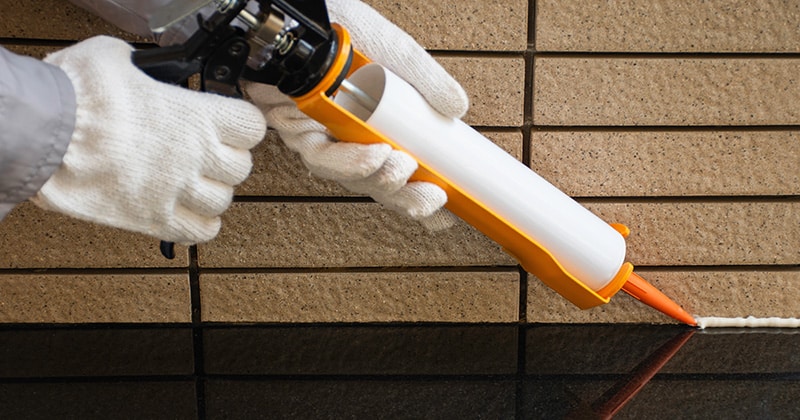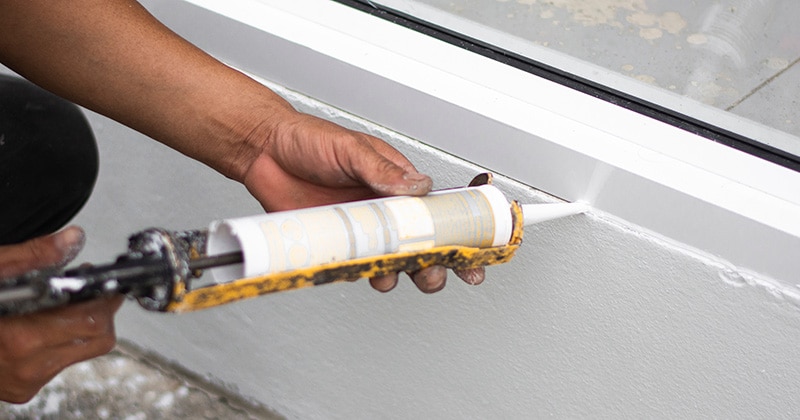The 7 Best Commercial Caulking Guns for General Contractors
Here, we review how to shop for a commercial caulking gun. Learn the different types of caulking guns. Get our top picks for caulking guns so you can find the best one for your professional use.

Staff Contributor
If you’re a general contractor, having the right caulking gun is essential for performance that affects your business profits. Here, we review how to shop for a commercial caulking gun.
Learn the different types of caulking guns. Get our top picks for caulking guns so you can find the best one for your professional use.
The Importance of Choosing the Right Caulking Gun
When you’re a general contractor, your tools can make or break a project. Get the right tool in your hands, and you can work quickly and efficiently.
But get the wrong tool? You wind up wasting time when it breaks. Or your results are subpar.
Not completing a job the way you envisioned it has multiple unpleasant consequences. First, there’s the likelihood that the homeowner won’t be pleased with the results. Then, that can turn into negative reviews online and lack of referral business.
Even more important, a job that doesn’t go right could have serious legal consequences. You could be liable for injuries or property damage that results from a failure.
A window doesn’t hold in a storm. A shower lever leaks water into the wall. Those things can lead to accidents and insurance claims or lawsuits.
General contractors get a huge amount of business through word of mouth, so that’s not a trivial thing. Your bottom line can be severely impacted by just a few jobs that don’t go as planned.
According to the Wharton School of Business, referred customers have a higher lifetime value than others (by 16%). And 92% of consumers trust family and friend recommendations more than advertising.
Tool or equipment failure also affects employees. At best, it’s a nuisance, and they can’t stay on schedule. At worst, safety could be compromised.
Worker injuries on the job result in thousands of workers’ compensation claims being filed every year in the U.S. Some employees may not be hurt enough to file an insurance claim, but they may call in sick. Repetitive use injuries due to poor ergonomics are another concern for contractors. This is true both for their employees and for themselves.
Caulking guns are construction and repair tools that seem harmless. However, if you use one for hours on end, your choice of gun makes a big difference.
You may end up with a job that looks messy and not properly sealed. Or you can achieve pristine caulking that makes the homeowner proud of their property.
If you’re like most general contractors, you use your caulking gun nearly every day. This tool is vital for sealing small gaps, like around windows or plumbing fixtures. Proper caulking reduces energy loss and prevents water infiltration. That’s why choosing the best commercial caulking gun is so important.

Key Features to Look for in Commercial Caulking Guns
Choosing a caulking gun isn’t merely a matter of going to the hardware store and grabbing the first one you see. You want to think about the types of projects you work on.
And you need to look at all the features that differentiate one tool from another. You want the caulking gun that checks the most boxes for you.
Once you read the reviews in the next section, you may be surprised at how different some models are from each other. It will likely make sense to buy several different caulking guns for various job types. Think of it like purchasing a range of paintbrushes because only one won’t work for every project.
What’s the Difference Between a Manual and an Electric Caulking Gun?
Manual caulking guns are what most contractors are accustomed to using. They’ve been around for generations, and they usually last for years.
These old-school caulking guns require you to squeeze a handle or trigger to dispense caulk. There are three downsides to this type of gun:
- Your hand can get tired, sore, or even injured from continuous or repetitive squeezing as a professional.
- Contractors with smaller hands, including women, can find the handles hard to operate due to their size.
- You need to use very steady pressure to apply an even bead of caulk, or the work will look clunky.
Electric caulking guns were invented to eliminate these problems. They are a subcategory of power caulking guns (see more below).
They use battery or AC power from an outlet, rather than hand pressure, to operate. You push the trigger once and get a steady stream of caulk.
Battery-powered guns are convenient because they’re cordless. But of course, there’s a limit to the amount of battery power you’ll get over a day.
With an electric caulking gun, you can work more quickly and get more consistent results. You won’t get the kind of hand pain that often accompanies the use of a conventional caulking gun.
You do have to be careful, though. As these caulking guns are more powerful, it’s easy to apply too much caulk. It takes a bit of practice to get the right touch with electric caulking guns.
What Are the Different Types of Caulking Guns?
There are other differences between caulking guns you should know about when shopping. Technology has come a long way recently, and there are also nuances between traditional caulking guns.
Within the manual caulking gun category, there are two basic subtypes:
- Ratchet lever caulking gun
- Polished caulking gun
A ratchet lever caulking gun is still probably the most common model. You find them everywhere tools are sold, and they’re popular with home DIYers because of their low price. But when you examine how it works, you’ll see why it’s being overtaken by other designs.
This type of gun uses a jagged push rod connected to a spring. To dispense caulk, you pull back on the lever and cut the tip of the tube first. Then, you insert the line into the caulking gun. Finally, you press the gun’s trigger to make the caulk come out.
Each time you press the trigger on a ratchet lever caulking gun, some caulk is dispensed. But you must release the trigger after every press to reset the mechanism to neutral. Then you start the process all over again for your next bead.
Another negative is that the ratchet lever caulking gun uses a pressure ratio of 5:1. Translated to practical usage, you must depress the trigger heavily to get the desired amount of caulk.
A polished caulking gun is the more user-friendly of the two manual types. With a force ratio of 10:1, you don’t have to press as hard to dispense caulk.
Not only do you get more professional-looking results with a polished gun. You also reduce hand strain, which is significant for contractors who use caulking guns for hours on end.
We mentioned above that the electric caulking gun is one type of power gun. The other type is the pneumatic caulking gun.
A pneumatic caulking gun uses air pressure to issue caulk from the tip. By adjusting the air pressure, you can control the amount of caulk dispensed.
If you’re pressing the trigger, you’ll get caulk from the gun. Let go of the trigger, and the caulking action stops.
While these pneumatic guns are great for large-scale jobs, like doing the doors and windows on an entire house, they have one downside. You must use an air compressor with it. If you don’t have a compressor, or if it’s being used for another purpose, it’s not a viable solution.
But wait, there’s more! Within each of these subtypes, you can divide caulking guns even further by the type of caulk containers they hold:
- Tube caulking guns are the most common. They take caulk that is sold in a tube container.
- Cartridge caulking guns use cartridges, which are more rigid than tubes.
- Sausage caulking guns accommodate special tubes that look like sausages (collapsible, with no tip). They hold more caulk and are great for large jobs.
- Bulk caulking guns are like sausage guns, but the piston design inside is different. It uses a suction mechanism to draw up caulk.
How Does Project Type Affect Your Choice of Caulking Gun?
By now, you’ve probably figured out that the type of project you’re working on dictates what type of caulking gun you choose. That’s why above we suggested purchasing a couple of different models for various scenarios.
For most small jobs, a manual caulking gun that uses a tube or cartridge will be fine. The less visible the spot you’re working on, the less it matters.
However, what if you’re working on a highly visible part of the client’s home? Or what if you need to use caulk over a long area? You’re better off with a power caulking gun.
Many contractors like sausage guns for their convenience and smooth application. However, bulk guns usually give you the biggest selection of caulk color and often take the fastest-drying brands of caulk too.
Occasionally, you will run into situations that call for special caulk and tools that can be used under more extreme conditions. So, for working with cement, for instance, or in very cold weather, look for guns made for those unique circumstances.
What Features Should You Consider When Choosing a Commercial Caulking Gun?
Having learned more about the variety of caulking guns on the market, what should be on your shopping checklist? Use these features as a guideline to find the right commercial caulking guns for your needs:
- Power source (manual vs. power)
- Ease of use and ergonomics
- Type and amount of caulk accommodated
- Speed and control of dispensing
- Ability to switch caulk quickly
We go into shopping criteria a bit more in the next section, where we make our model recommendations.

The 7 Best Commercial Caulking Guns for General Contractors
Below are our suggestions for the best commercial caulking guns. In addition to the factors listed above, we also used these concerns to select models for you:
- Cost and value for the price
- Features for best results
- Lifespan and durability
- Brand reputation and reviews
For Basic No-Frills Caulking: Project Source 10-oz Anti-drip Rod Caulk Gun
If you don’t do a lot of caulking, or if you need an extra gun, this model is a solid choice. On the low end of professional models, it’s very reasonably priced and offers a 13:1 pressure ratio.
Users like the corrosion-resistant aluminum alloy handle on this polished caulking gun. They also appreciate its dripless design and ability to handle corners neatly.
It includes a seal puncture, spout cutter, and ladder hook for convenience.
That said, it’s on the small side volume-wise. And the force ratio is low if you need to use it for more than an hour or so.
Upgrading a Step: Newborn 250 Super Smooth Rod Revolving Frame Caulking Gun
This Newborn caulking gun is very similar to the one reviewed above at about $10 more. But with a thrust ratio of 18:1, it’s easier on the hands.
A thumb release makes dripless operation a breeze for clean jobs. Users find it super smooth for applying both caulk and sealant. However, some commented that only one half of the handle was rubber coated. This makes it uncomfortable for extended use.
Better Manual Ergonomics: Albion B26 Caulking Gun
Albion has a reputation for producing some of the best caulking guns in the business. This model is a fantastic option if you want the higher compression ratio of 26:1.
Available in two different capacities, this gun is ideal for working with polyurethane. And it particularly shines in cold climates. It offers many of the same features as the models above. Plus, key components can be replaced if the gun wears out over time.
The only negative with this model is the price. You’ll pay at least three times as much as you would for an entry-level gun. At that price, is it better to look at power models?
Highly Rated Sausage Gun: Newborn 620 AL
If you like the low waste and high volume of a sausage caulking gun, this might be the model for you.
Users especially like it for air sealant and waterproofing. It has an 18:1 pressure ratio, so it’s on the upper end of the spectrum for manual guns.
You’ll pay a bit for this manual model, however. Expect to shell out at least $70 for it. And it can be harder to find at hardware and home improvement stores.
Best Powered Sausage Gun: Milwaukee M12 Sausage Gun
Want the benefits of a sausage gun without any fatigue? Try this model from Milwaukee, which features a comfort grip.
It also has a ladder hook and a reusable nozzle for convenience. You’ll pay around $200 for this caulking gun. That can be a sticking point for startup contractors.
But it comes with its own lithium battery and charger. The battery can be used with dozens of other Milwaukee M12 series tools, so it may be a worthwhile purchase in the end.
For Dispensing Thick Sealants: PC Products Steel Dispensing Caulking Gun
Professional contractors rave about this PC Products model for handling high-viscosity materials. Features they appreciate include:
- Workhorse 26:1 pressure ratio
- Steel fabrication
- Revolving frame
- Smooth action
If you deal with concrete epoxy on a regular basis, consider this gun. But know that it does not come with a tip cutter, meaning you need a separate tool for that. And if you want to go from the standard 250 ml to a 600 ml volume, you’ll more than double the price.
For comparison, Dewalt makes a similar cartridge gun with an interchangeable battery. But you pay extra for the battery and charger. The bare tool alone is the same price as the Milwaukee.
Power at a Reasonable Price: Chicago Pneumatic CP9885 – Air Caulking Gun
Are you interested in power caulking guns but have a limited budget? If you own an air compressor, the Chicago CP9885 is worth looking at.
General contractors love this gun for extra-large projects, like doing an entire house or full kitchen remodel.
The ergonomics are superior, with virtually no pressure needed. And it accepts standard cartridges with ease. User reviews frequently mention the clean and smooth results they get from it.
If you’ve never used a pneumatic gun, though, it will take some getting used to. To achieve that dripless, consistent bead of caulk, you’ll have to play with the settings a bit to find the sweet spot.
Top Takeaway Tips for Selecting a Commercial Caulking Gun
-
Talk to local peers and/or your employees about what they like and don’t like about different caulking guns. They are most likely to understand your unique needs.
-
Be certain to ask about warranties and return policies. Most caulking guns are straightforward. But if you run into a problem, you don’t want to lose workdays (billable hours) waiting for a repair or replacement.
-
Get a feel for different compression ratios by trying out a variety of caulking guns whenever possible. See the difference between a regular 5:1 or 10:1 ratio and something designed for commercial use, like 26:1.
-
Do you work with adhesives in addition to caulk? If so, you want a caulking gun that comes with a seal puncture tool. This is a necessary step to permit the adhesive to cure properly.
-
Don’t rule out a pneumatic gun just because you don’t have an air compressor. Is a compressor something you could use elsewhere in your business? It might be smart to invest in one. Always shop for tools and equipment for where you want your business to be in 6 months or a year from now.
-
Make sure any workers you hire are up to speed on how to use new caulking guns. If you invest in a power gun, for instance, employees who are used to old manual guns may need a practice session. Once they get the hang of it, your clients are sure to be impressed with your results.
Alison began her career as a storyteller crafting a variety of engaging content. She has experience in creative writing, marketing, social media, and education. When she's not writing, she's spending time with her family and dog.


